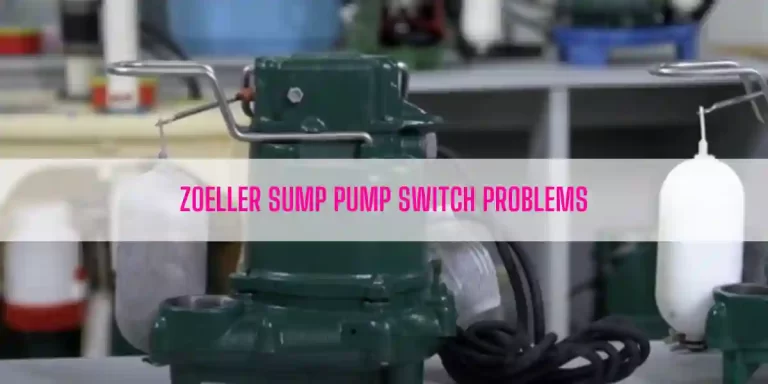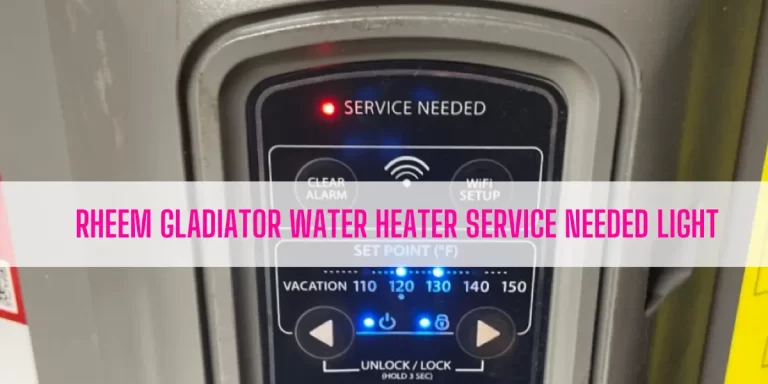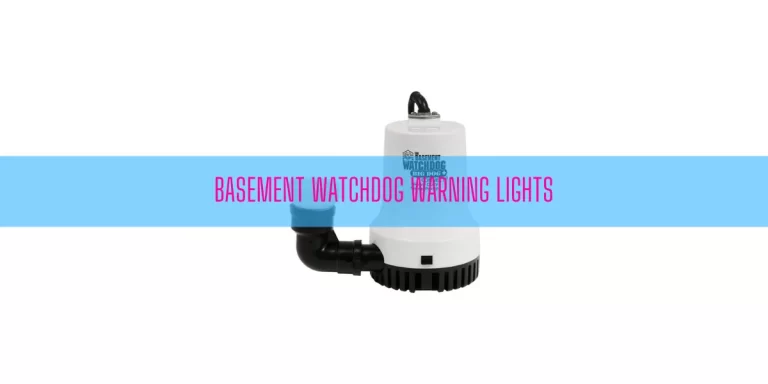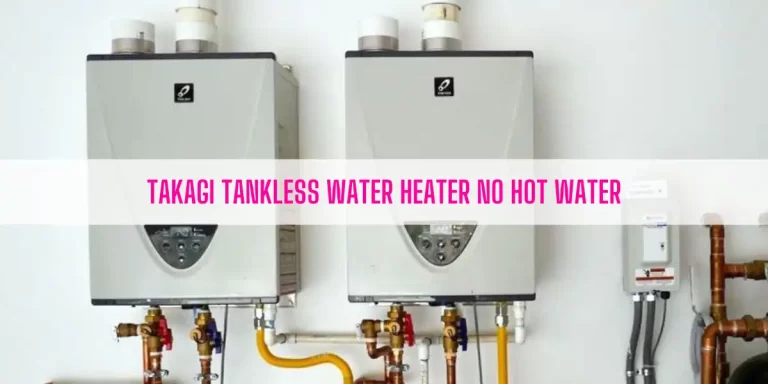This guide covers Richmond Water Heater troubleshooting, including issues like:
- No hot water
- Temperature fluctuation
- Pilot light won’t stay lit
- Yellow flame or soot
- Failure to light the main burner
- The main burner not staying lit
Each problem has a solution, so you can follow the steps to repair your water heater and save time and money.
Let’s get started.
Troubleshooting 10 Common Richmond Water Heater Problems
This chapter will walk you through the most common problems of a Richmond Water Heater and how you troubleshoot them.
1. Insufficient or No Hot Water
You may get little to no hot water from your Richmond Water Heater due to:
- Exceeding the heater’s capacity
- Low gas pressure
- Thermostat set too low
- Hot water faucets left open
- Gas valve error codes
- On-off switch in the off position
- Unplugged inducer
- Tripped combustion shut-off system
How To Fix:
Allow your water heater time to recover after heavy usage. It’s important to have a properly sized unit to meet your daily needs.
If the gas pressure is low, refer to the manual and adjust the gas supply and manifold pressure.
You may also experience insufficient hot water if the thermostat is set too low. Check the thermostat and adjust it to your desired temperature.
Make sure all hot water faucets are closed while the heater is operating, and verify that the on/off switch is in the “On” position.
If the inducer is unplugged, the water heater won’t deliver hot water, so be sure it’s properly plugged in.
Lastly, if the combustion shut-off system is tripped, have a technician inspect and replace it if necessary.
2. Pilot Light Won’t Stay Lit
Richmond water heater’s pilot light won’t stay lit due to a problem with the thermocouple or the gas control valve.
The thermocouple is a safety device that detects whether the pilot light is on. If the thermocouple is at fault, it may incorrectly signal that the pilot light is out, causing the gas supply to shut off.
On the other hand, the gas control valve on your water heater controls the gas supply flow to the unit. Due to a faulty gas control valve, no gas will flow to your water heater to light the pilot.
How To Fix:
First, check the thermocouple electrically with a multimeter. A healthy thermocouple will give you a reading of about 25-30 millivolts. Anything significantly lower suggests it needs replacement.
If replacing the thermocouple doesn’t resolve the pilot light issue, it’s time to check the gas control valve.
I recommend you read this guide on Richmond Water Heater Pilot Light Won’t Light.
In that guide, I explained how to test the thermocouple with a multimeter and replace it. Additionally, I described how to replace the gas control valve.
3. Temperature Fluctuation
Temperature fluctuation in the Richmond Water Heater is another common problem that can be inconvenient. You will experience this issue due to incorrect thermostat adjustment or sediment buildup.
How To Fix:
To fix the inconsistent water temperature issue, adjust the thermostat first. Follow these steps to adjust the thermostat:
1. Locate the thermostat behind an access panel on the side of the tank.
2. Ensure the thermostat is set between 120°F and 140°F for optimal performance and safety.
3. If adjusting the thermostat doesn’t resolve the issue, test it with a multimeter:
- Disconnect the power to the unit.
- Remove the access panels to reach the thermostat.
- Use a multimeter to check for continuity. If there is no continuity at a specific temperature, replace the thermostat.
If the problem persists after adjusting or replacing the thermostat, I bet the temperature fluctuates due to sediment buildup.
To learn how to flush the tank water heater, read this section: How Do I Drain Richmond Water Heater.
4. Yellow Flame or Soot
The following reasons are responsible for the yellow flame or soot issue:
- Scale buildup on the top of the burner
- Restricted flue or combustion air inlet openings
- The location where you install the water heater doesn’t get sufficient amount of air supply for combustion or ventilation
How To Fix:
Clean any dirt, dust, or scale from the top of the burner. To do this, remove the burner from the unit. Before removing the burner, ensure the following:
- Turn off the gas supply to your water heater and set the pilot to the “Off” position.
- Detach everything connected to the gas control valve, such as the wire connectors, pilot tube, and gas tube.
- Once everything is disconnected, remove the burner.
- Clean the top of the burner with soapy water to remove debris or scale buildup. Let the burner dry completely before reinstalling it.
- Reinstall the burner once it’s dry.
- Reconnect everything to the gas control valve.
- Set the pilot to the “On” position and turn on the gas supply.
- Finally, turn on your water heater.
Secondly, check the flue or combustion air inlet openings for obstructions or dirt. Clear any obstructions to ensure proper water heater operation.
Thirdly, ensure your water heater is installed in a well-ventilated area. For optimal performance, the heater should be in an unconfined space.
If there’s any obstruction, there should be at least a 1-inch gap between the combustion air inlet openings and the blockage. Ensure the flammable vapor sensor is not blocked under any circumstances.
Lastly, always refer to the manual and follow the manufacturer’s installation guide. It’s best to have your water heater professionally installed.
5. Fail To Light The Main Burner
You can’t light the main burner of your Richmond Water Heater if:
- There is air in the gas line.
- The vent or exhaust pipe gets blocked
- Kinked or clogged pressure switch hose
- Loose wire connections
- Faulty gas control
How To Fix:
There should be no air in the gas line. If there is, you must purge it, or the main burner won’t light. To purge the air, pop open the pressure relief valve to let the air escape from the water tank.
This will allow more water to flow in as the air exits. When the valve is open, you’ll hear a hissing sound, indicating the air is leaving the gas line.
Be careful to close the valve when the water level starts rising, or it may flood your floor.
Next, turn on the hot water at the bathroom sink, kitchen sink, and shower. It will spit some air along with a bit of water. Keep the faucets open until a steady stream of water flows.
After that, inspect the vent piping for blockages. You can disconnect the vent and check visually, but it’s a good idea to contact a qualified technician to examine the exhaust pipe.
Also, check the pressure switch hose for clogs. If it’s blocked, clean it, or straighten the hose if it’s bent.
Loose wiring can also prevent the main burner from lighting. Ensure all wire connections are secure and tight. If you’re not familiar with electrical work, hire an electrician to inspect the wiring.
Lastly, a faulty gas control valve could be the cause. If it’s defective, you’ll need to replace it.
6. Main Burner Doesn’t Stay Lit
Richmond Gas Water Heater features a combustion shut-off device. It automatically shuts the unit down whenever it senses the presence or flammable vapor or the air inlet openings get blocked. If the combustion shut-off device is at fault or gets tripped, it will turn off the unit and the main burner won’t stay lit anymore.
How To Fix:
Dealing with the combustion shut-off device requires professional knowledge. So, I highly recommend you call a certified service technician to inspect the combustion shut-off device. If needed, replace it.
7. Rumbling Noise
If you hear a hissing or rumbling noise from your water heater, I bet scale or lime forms on the bottom of the water tank. The only way you can stop this noise is to drain water from the tank. In the below ‘How To Fix’ section, I will show you how to drain water.
How To Fix:
Before draining water, shut off the gas supply to your water heater. Next, turn on hot water faucets somewhere in your house to allow cold water into the tank to avoid scald injury.
Once the tank of the water heater is cold, shut off the cold water supply to your water heater. What you need to do next is- attach a garden hose to the drain valve at the bottom of the water heater. Then, place the other end of the hose to the nearest floor drain.
Now, open the drain valve to let the water drain.
8. Relief Valve Making Popping Noise
Pressure buildup caused by thermal expansion is the main culprit that causes the relief valve to produce a popping noise. It’s such a dangerous situation you can’t ignore. Otherwise, it may blow out your water heater.
How To Fix:
Thermal Expansion is an unacceptable condition and you must solve it right off the bat. Whenever the relief valve generates the hissing noise, turn off your water heater. Then, call a certified service technician to fix this issue. Keep in mind; replacing the relief valve will not solve this problem.
9. Too Hot Water
Excessive hot water output means either you set the thermostat too high or the gas control valve gets defective.
How To Fix:
Check the thermostat and set it to the desired temperature setting. Next, inspect the gas control valve and replace it if needed. The following video will help you in changing the gas control system:
However, I recommend you hire a certified plumber to do this task for you.
10. Condensation
Condensation! It’s not a problem in the real sense. It actually happens when you fill your new Richmond Water Heater for the first time. Moisture from the products of combustion condensing on the tank surface also cause this issue.
Besides, if you install an undersized water heater that fails to meet your needs, it will produce condensation.
How To Fix:
It’s normal. The condensation will disappear once the water in the tank warms up. However, if this problem persists, go forward to check piping and fittings for leaks. Finally, ensure you install the correct size of water heater for your home to avoid the condensation issue.
How Do I Drain Richmond Water Heater?
To drain or flush your Richmond Water Heater, follow these steps:
- Turn off the gas supply to the unit.
- Turn the cold water valve clockwise to shut off the water supply to your water heater.
- Attach a drain hose to the drain valve and place the other end to the nearest floor drain or outdoor.
- Open the drain valve to let the water drain. You can open a hot water faucet to speed up the draining process.
- Once you drain the tank, detach the hose and close the drain valve.
- Turn the cold water valve counterclockwise to turn on the water supply.
- Open the gas supply valve to let the gas flow continuously.
- Once you fill the tank with water, close the water supply valve.
- Now, ignite the water heater by following the instructions mentioned in the user manual.
Conclusion
You experience a problem with your Richmond Water Heater doesn’t mean you need to call for a service. If you follow this guide on Richmond Water Heater Troubleshooting, it will help you detect the issue of your water heater.
Plus, I also mentioned how you can troubleshoot and fix the problem. As a result, you don’t need to spend your hard-earned money for a little issue.
However, never hesitate to call a certified plumber if you can’t solve a specific problem by following the troubleshooting steps I mentioned. And guess what, not every problem has a DIY solution.

Eric Alvarez is the head of content on LilDutchUncle.Com. He is an HVAC guy based in El Paso, Texas, United States. He obtained his Bachelor of Science degree from the University Of Texas at El Paso. Years of experience in the HVAC field have taught him many lessons, not the least of which is that the value of quality and knowledge far exceeds any promised initial savings. He has a good standing reputation for superior skills in heating, air conditioning, hot water tanks, and indoor air quality systems.

![Rheem Rtex-18 Troubleshooting [Complete Guide]](https://lildutchuncle.com/wp-content/uploads/2023/10/Rheem-Rtex-18-Troubleshooting-Complete-Guide-768x384.webp)



